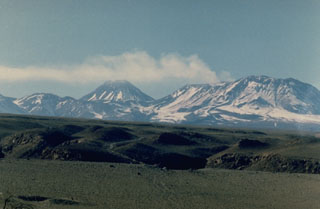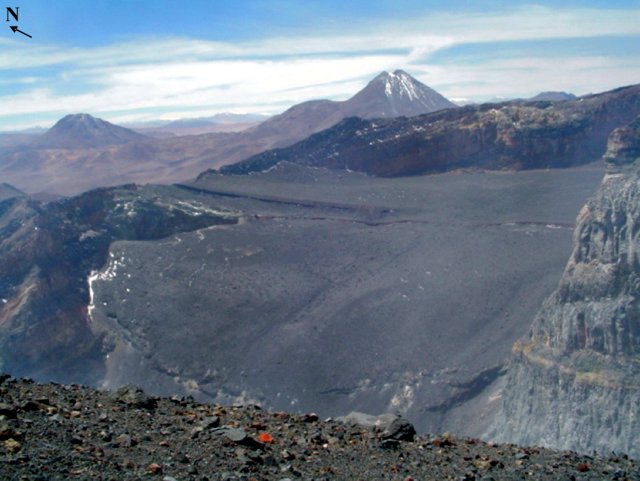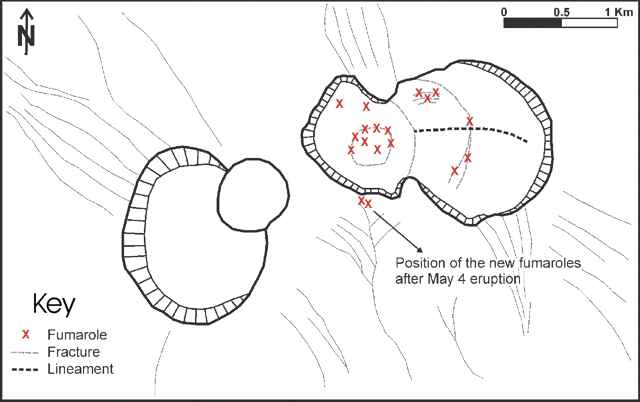Report on Lascar (Chile) — May 2005
Bulletin of the Global Volcanism Network, vol. 30, no. 5 (May 2005)
Managing Editor: Richard Wunderman.
Lascar (Chile) Further analysis of 4 May 2005 event indicates a phreato-Vulcanian eruption
Please cite this report as:
Global Volcanism Program, 2005. Report on Lascar (Chile) (Wunderman, R., ed.). Bulletin of the Global Volcanism Network, 30:5. Smithsonian Institution. https://doi.org/10.5479/si.GVP.BGVN200505-355100
Lascar
Chile
23.37°S, 67.73°W; summit elev. 5592 m
All times are local (unless otherwise noted)
The 4 May 2005 early morning eruption of Lascar was described in BGVN 30:04. Note that the time conversion in that issue was in error by 1 hour. The following information is based on a report prepared for Bulletin staff by Jose Viramonte of the Universidad Nacional de Salta, and Lizzette Rodriguez of Michigan Technological University.
Viramonte and Rodriguez estimated that the 4 May 2005 eruption column rose to a height of ~ 10-11 km, based on numerical models of temperature and wind measurements from the Servicio Metereológico Nacional, Argentina at different altitudes at the time of the eruption. The column traveled rapidly to the SE under the influence of the strong tropospheric winds with predominant direction from the NW to the SE.
Residents of the towns of Talabre (located 15 km W of the volcano) and Jama (located 60 km ENE of the volcano) did not report earthquakes or explosions. The Instituto GEONORTE of the Universidad Nacional de Salta reported very fine ashfall at 0545 in the city of Salta, located ~ 285 km SSE of the volcano. Ash sample collection, carried out by GEONORTE personnel for 2.5 hours, measured a rate of 0.4 g/ (m2 h). Grain size analyses of the ash showed a strong mode at diameters of 4-8 phi (0.062-0.003 mm) (figure 29); the ash was composed predominantly of andesitic lithic fragments and broken crystals of two pyroxenes (hyperstene and augite) and plagioclase, with very scarce glass shards.
 |
Figure 29. Histogram of the grain size of ash deposited at the city of Salta by the 4 May 2005 Lascar eruption. Courtesy of Jose Viramonte and Lizzette Rodriguez. |
The Buenos Aires VAAC and the Comisión Nacional de Actividades Espaciales (CONAE) processed different bands from MODIS data: b29-b32 for SO2, b31-b32 for ash, and b30-b32 for SO4. The first two band combinations showed the Lascar plume in coincidence with the b5-b4 band combination from NOAA-17 (figure 30).
The grain size and shape of the ash, its composition, and the interpretation of the satellite data, suggest that Lascar volcano had a short phreato-vulcanian eruption.
On May 25, Felipe Aguilera of the Universidad Católica del Norte, Antofagasta, Chile, climbed up to the crater of Lascar volcano (figure 31). He reported three new strong fumaroles a few meters from the S border of the crater, and sampled the sulfur sublimates (figure 32). No new bombs or blocks were seen around the crater area.
Recent and future work. A team of scientists from Michigan Technological University, the University of Hawaii, the Universidad Nacional de Salta, the Universidad de Chile, and the Universidad Nacional de Córdoba, conducted a field campaign at Lascar from 29 November to 8 December 2004. During this period, SO2 emissions were measured using two mini-UV spectrometers; aerosols were measured using two Microtops II sun photometers, and temperatures of the vent fumaroles were measured using a Forward Looking IR Radiometer (FLIR). Preliminary processing of the gas data showed a decrease since 2003 in the emissions, with SO2 fluxes around 500 tons/day (Rodríguez et al., 2005). This contrasts with the fluxes determined by Mather et al. (2004) on January 2003, which were on the order of 2,300 tons/day. Observations of the SO2 index, using ASTER TIR images, have shown a decrease in the size of the SO2 anomaly from 2000 to the first half of 2004 (Castro Godoy and Viramonte, 2004).
Temperature measurements made at the crater on 2 December 2004 by University of Hawaii scientists using a FLIR indicated low temperatures for the fumarole field, which represented a decrease when compared with the results of direct measurements conducted in October 2002 by Franco Tassi and others (Tassi et al., 2004; BGVN 28:03). Similar observations have been made using ASTER SWIR and TIR images (Silvia Castro, GEOSAR-AR program), which have shown a decrease in the absolute temperatures and the size of the thermal anomaly since October 2002 (Castro Godoy and Viramonte, 2004). Images during the month of April 2005 showed a slight increase in the area and maximum temperature of the anomaly at the beginning of the month, followed by a decrease at the end of April, prior to the eruption. Decreases in the thermal activity have been observed in previous eruptive cycles, prior to explosive events (Oppenheimer et al., 1993; Matthews et al., 1997).
The data collected during the 2004 field campaign will help in the understanding of the pre-eruptive conditions at Lascar. SO2 emission rates on 7 December 2004 will be used to ground truth the satellite data from an ASTER overpass at 1436 UTC (1036 local time), and recently acquired ASTER data will be used to investigate SO2 emissions during the period close to the 4 May 2005 eruption. Scientists from Università degli studi di Firenze (Italy), Universidad Católica del Norte (Chile), and Universidad Nacional de Salta (Argentina) are conducting a systematic gas sample campaign at Lascar and other active volcanoes on the Central Volcanic Zone. Finally, scientists from the Universidad Católica del Norte and the Universidad Nacional de Salta are processing data from Landsat TM and ETM+ images, with the objective of understanding the behavior of Lascar volcano during the 1998-2004 period.
References. Castro Godoy, S. and Viramonte, J.G., 2004, Micro FTIR field measurement for volcanic mapping, SO2 and temperature monitoring using ASTER images in Lascar Volcano, southern central Andes: IAVCEI General Assembly, Book of Abstracts, Pucón, Chile, 14-20 November.
Mather, T.A., Tsanev, V.I., Pyle, D.M., McGonigle, A.J.S., Oppenheimer, C., and Allen, A.G., 2004, Characterization and evolution of tropospheric plumes from Lascar and Villarrica volcanoes, Chile: Journal of Geophysical Research, v. 109.
Matthews, S.J., Gardeweg, M.C., and Sparks, R.S.J., 1997, The 1984 to 1996 cyclic activity of Lascar volcano, northern Chile: cycles of dome growth, dome subsidence, degassing and explosive eruptions: Bulletin of Volcanology, v. 59, p.72-82.
Oppenheimer, C., Francis, P., Rothery, D., Carlton, D., and Glaze, L., 1993, Interpretation and comparison of volcanic thermal anomalies in Landsat Thematic Mapper infrared data: Volcán Lascar, Chile, 1984-1991: Journal of Geophysical Research, 98, p. 4269-4286.
Rodríguez, L.A., Watson, I.M., Viramonte, J., Hards, V., Edmonds, M., Cabrera, A., Oppenheimer, C., Rose, W.I., and Bluth, G.J.S., 2005, SO2 conversion rates at Lascar and Soufriere Hills volcanoes: 9th Gas Workshop, Palermo, Italy, May 1-10.
Tassi, F., Viramonte, J., Vaselli, O., Poodts, M., Aguilera, F., Martínez, C., Rodríguez, L.A., and Watson, I.M., 2004, First geochemical data from fumarolic gases at Lascar volcano, Chile: 32nd International Geological Congress, Florence, August 20-28, 2004.
Geological Summary. Láscar is the most active volcano of the northern Chilean Andes. The andesitic-to-dacitic stratovolcano contains six overlapping summit craters. Prominent lava flows descend its NW flanks. An older, higher stratovolcano 5 km E, Volcán Aguas Calientes, displays a well-developed summit crater and a probable Holocene lava flow near its summit (de Silva and Francis, 1991). Láscar consists of two major edifices; activity began at the eastern volcano and then shifted to the western cone. The largest eruption took place about 26,500 years ago, and following the eruption of the Tumbres scoria flow about 9000 years ago, activity shifted back to the eastern edifice, where three overlapping craters were formed. Frequent small-to-moderate explosive eruptions have been recorded since the mid-19th century, along with periodic larger eruptions that produced ashfall hundreds of kilometers away. The largest historical eruption took place in 1993, producing pyroclastic flows to 8.5 km NW of the summit and ashfall in Buenos Aires.
Information Contacts: Raúl Becchio and José G. Viramonte, Instituto GEONORTE and CONICET, Universidad Nacional de Salta, Buenos Aires 177, Salta 4400, Argentina (URL: http://www.unsa.edu.ar/); Lizzette A. Rodríguez and Matthew Watson, Michigan Technological University, Houghton, MI 49931, USA (URL: http://www.geo.mtu.edu/volcanoes/); Felipe Aguilera, Universidad Católica del Norte, Avenida Angamos 0610, Antofagasta, Chile (URL: http://www.ucn.cl/en/carrera/geology/); Silvia Castro Godoy, GEOSAT-AR Project, SEGEMAR, Buenos Aires, Argentina (URL: http://www.segemar.gov.ar/); Matt Patrick and Rob Wright, HIGP-University of Hawaii, Honolulu, HI 96822, USA (URL: http://www.higp.hawaii.edu/volcanology.html); Sergio Haspert and Ricardo Valenti, VAAC Buenos Aires - Div. VMSR, Servicio Meteorologico Nacional, Argentina (URL: http://www.smn.gov.ar/vaac/buenosaires/productos.php).




